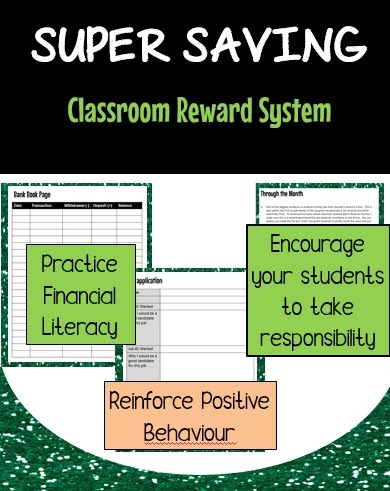
You’ve seen the kids that don’t understand money and yet they’ve been taught money every year. In fact, you may have even taught them money but when it comes down to it they just don’t understand how to apply this in the real world. Sound familiar? I experienced all of this and more in my own classroom and decided that my students would benefit from real-world math. You know what I mean. Math that involves choosing whether to rent or to buy. Math that involves whether or not you buy that thing you want or you keep saving for items like cars and a house.
That’s why in my classroom I started using a saving system to not only motivate students, but also to improve their financial literacy. I make them keep track of monthly expenses, they get paid to do jobs, and they can choose to rent their desk or own it and avoid the rent. All of these are something that I felt would be beneficial to students. (It’s also nice to see whether they complete calculations accurately). Depending on the age group I’m teaching (it seems to change every year), I also have them calculate taxes in April and sometimes have them calculate their utility and internet costs, but I’m getting ahead of myself.
We start the year by identifying all the jobs that need doing in the room. I run a neat room and don’t like clutter or mess so this system also puts the kids in charge of these items. I brainstorm this with the kids but usually end up with the same variety of jobs that need doing. My top jobs are always a teacher assistant to help hand things out, a custodian to sweep floors and clean tables, and attendance support (because if it’s one thing I can’t remember it’s to take attendance). If you run a financial system your jobs will be different I’m sure. Then kids write me a letter trying to convince me to hire them for their top three jobs. This is also a great way to get a sense of their writing abilities.

After writing letters I hire them for their jobs and as a class, we go over what is expected with each job. I know I know, this sounds like a ton of work at the beginning of the year. I could lie and tell you it isn’t but I doubt you would like me later. It’s a lot of front loading. However, I have to say by Christmas my room is spotless and tasks are done without me directing or as my husband might say – nagging. I don’t run my room, my kids do. At the end of the month, I pay them for doing their tasks. However, we talk ahead – if they aren’t actually doing their jobs every day I offer them to someone else and I don’t pay for jobs that aren’t done.
After writing letters I hire them for their jobs and as a class we go over what is expected with each job. I know I know, this sounds like a ton of work at the beginning of the year. I could lie and tell you it isn’t but I doubt you would like me later. It’s a lot of front loading. However, I have to say by Christmas my room is spotless and tasks are done without me directing or as my husband might say – nagging. I don’t run my room, my kids do. At the end of the month I pay them for doing their tasks. However we talk ahead – if they aren’t actually doing their jobs every day I offer them to someone else and I don’t pay for jobs that aren’t done. They also get an additional amount for being a student and they can eventually use their money to buy the deed to their desk. At this time they subtract rent from their paycheck amount. Unless they are doing a job they will just barely cover the rent. Usually at the end of the month I run a small reward centre. This is as simple as candies or can be as elaborate as bringing in doughnuts – whatever works. I’ve done extra gym time as well and in my super saving program I go over all of the possibilities. Students have to make the choice to save or spend.
I’ve run this program with so many classes and I’m always amazed at the thankfulness from parents that I get for this. It’s such a small part of my day but it makes the parents so happy to know that their children are working with ‘money’ regularly and can understand the concept of saving. Hopefully, you can use it in some small way to help incorporate financial literacy into your daily or weekly routine.